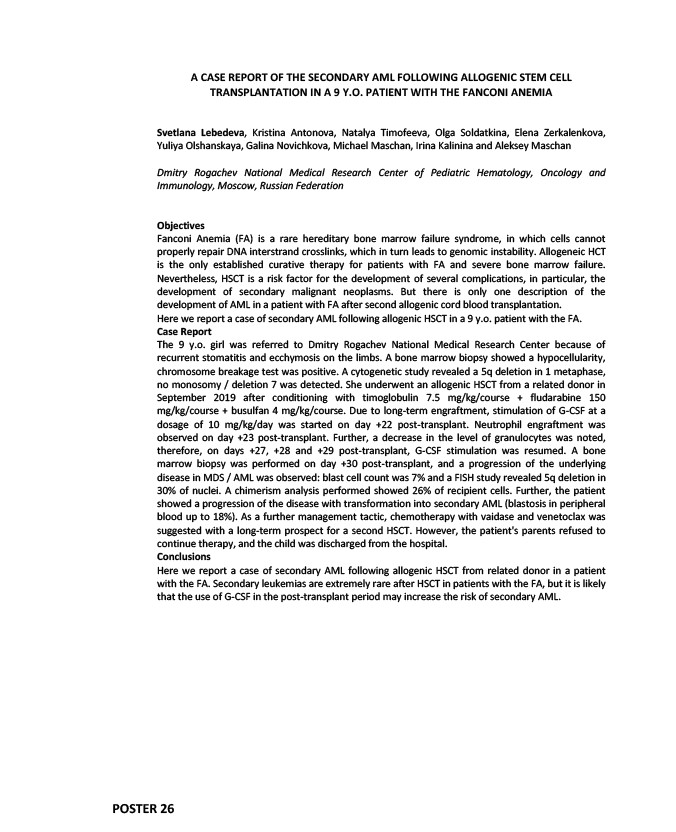
POSTER 26
A CASE REPORT OF THE SECONDARY AML FOLLOWING ALLOGENIC STEM CELL
TRANSPLANTATION IN A 9 Y.O. PATIENT WITH THE FANCONI ANEMIA
Svetlana Lebedeva, Kristina Antonova, Natalya Timofeeva, Olga Soldatkina, Elena Zerkalenkova,
Yuliya Olshanskaya, Galina Novichkova, Michael Maschan, Irina Kalinina and Aleksey Maschan
Dmitry Rogachev National Medical Research Center of Pediatric Hematology, Oncology and
Immunology, Moscow, Russian Federation
Objectives
Fanconi Anemia (FA) is a rare hereditary bone marrow failure syndrome, in which cells cannot
properly repair DNA interstrand crosslinks, which in turn leads to genomic instability. Allogeneic HCT
is the only established curative therapy for patients with FA and severe bone marrow failure.
Nevertheless, HSCT is a risk factor for the development of several complications, in particular, the
development of secondary malignant neoplasms. But there is only one description of the
development of AML in a patient with FA after second allogenic cord blood transplantation.
Here we report a case of secondary AML following allogenic HSCT in a 9 y.o. patient with the FA.
Case Report
The 9 y.o. girl was referred to Dmitry Rogachev National Medical Research Center because of
recurrent stomatitis and ecchymosis on the limbs. A bone marrow biopsy showed a hypocellularity,
chromosome breakage test was positive. A cytogenetic study revealed a 5q deletion in 1 metaphase,
no monosomy / deletion 7 was detected. She underwent an allogenic HSCT from a related donor in
September 2019 after conditioning with timoglobulin 7.5 mg/kg/course + fludarabine 150
mg/kg/course + busulfan 4 mg/kg/course. Due to long-term engraftment, stimulation of G-CSF at a
dosage of 10 mg/kg/day was started on day +22 post-transplant. Neutrophil engraftment was
observed on day +23 post-transplant. Further, a decrease in the level of granulocytes was noted,
therefore, on days +27, +28 and +29 post-transplant, G-CSF stimulation was resumed. A bone
marrow biopsy was performed on day +30 post-transplant, and a progression of the underlying
disease in MDS / AML was observed: blast cell count was 7% and a FISH study revealed 5q deletion in
30% of nuclei. A chimerism analysis performed showed 26% of recipient cells. Further, the patient
showed a progression of the disease with transformation into secondary AML (blastosis in peripheral
blood up to 18%). As a further management tactic, chemotherapy with vaidase and venetoclax was
suggested with a long-term prospect for a second HSCT. However, the patient's parents refused to
continue therapy, and the child was discharged from the hospital.
Conclusions
Here we report a case of secondary AML following allogenic HSCT from related donor in a patient
with the FA. Secondary leukemias are extremely rare after HSCT in patients with the FA, but it is likely
that the use of G-CSF in the post-transplant period may increase the risk of secondary AML.